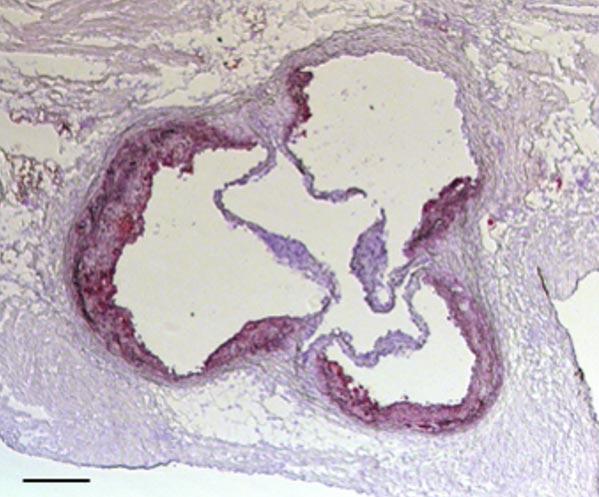Cardiovascular disease: Atherosclerosis and the immune system

Mouse lacking the T cell - dendritic cell CD40L-CD40 axis. | © LMU Klinikum
Medical researchers at LMU have uncovered how signal proteins of the immune system regulate the development of atherosclerosis.
Atherosclerosis is one of the most common causes of death in Germany. The condition is characterized by the build-up of cholesterol and other fatty metabolites in the arterial wall directly below the endothelial cell layer, which is in direct contact with the bloodstream. This process results in constriction of the artery, which obstructs blood flow and can trigger heart attacks and strokes. Atherosclerosis is generally treated with drugs that reduce the concentration of lipids in the circulation, often using compounds called statins.
However, statins effectively reduce the risk of cardiovascular disease in only 35 to 40% of the patients treated. The remaining 60% fail to respond to the medication. This has prompted the search for other drug targets. Since atherosclerosis is linked to chronic inflammatory processes, the immune system might offer new therapeutic options for tackling the disease. A group of researchers led by Professor Esther Lutgens and Dr. Dorothee Atzler at the LMU Medical Center have now elucidated an important component of the immune reaction involved in atherogenesis.
Immunotherapy as a treatment for atherosclerosis
Lutgens and her team at the Institute for Cardiovascular Prevention (Director: Prof. Dr. Christian Weber) and at the University of Amsterdam have now shown that the interaction between proteins called CD40L and CD40 represents a promising drug target for the suppression of atherosclerosis. The protein CD40L is synthesized by, and expressed on the surface of specialized cells of the immune system. It is recognized by the CD40 protein, a membrane-bound receptor that is expressed on antigen-presenting cells. However, CD40L also binds to receptors on other cell types that have diverse physiological functions. Using a mouse model, the LMU researchers deleted the gene for CD40L specifically in T cells and platelets as well as its counterpart, CD40, on dendritic cells. They then crossed these mice with a strain that is particularly prone to develop atherosclerosis.
Secretion of interferon-gamma by T-cells is known to stimulate immune functions, but the CD40L-deficient T-cells were found to secrete less interferon-gamma than those in which the gene is intact. In addition, further experiments indeed showed that, in the absence of CD40L in T-cells, the atherosclerotic plaques that formed were smaller and more stable. This suggests that inhibition of CD40L could enhance the stability of atherosclerotic plaques, and thus reduce the incidence of heart attacks induced by the rupture of blood vessels.
Similar results were obtained in a mouse strain that was unable to produce CD40 in dendritic cells. Deletion of CD40L in platelets, on the other hand, had no effect on the incidence of atherosclerosis, but it was associated with a reduction in atherosclerosis-associated clot formation.
“Our results provide clear evidence for differential, cell-type-specific functions of the CD40L/CD40 interaction in the context of atherosclerosis, and this has implications for therapeutic strategies that focus on this signaling pathway,” says Lutgens. Her group is now extending their studies of the effects of CD40 und CD40L to other cell types, with the aim of developing drugs that can inhibit the functions of these proteins in a cell-specific fashion. In principle, this could be done by using either small-molecule inhibitors or bifunctional antibodies with different binding sites.
All latest news from the category: Health and Medicine
This subject area encompasses research and studies in the field of human medicine.
Among the wide-ranging list of topics covered here are anesthesiology, anatomy, surgery, human genetics, hygiene and environmental medicine, internal medicine, neurology, pharmacology, physiology, urology and dental medicine.
Newest articles

Hyperspectral imaging lidar system achieves remote plastic identification
New technology could remotely identify various types of plastics, offering a valuable tool for future monitoring and analysis of oceanic plastic pollution. Researchers have developed a new hyperspectral Raman imaging…

SwRI awarded $26 million to develop NOAA magnetometers
SW-MAG data will help NOAA predict, mitigate the effects of space weather. NASA and the National Oceanic and Atmospheric Administration (NOAA) recently awarded Southwest Research Institute a $26 million contract…

Protein that helps cancer cells dodge CAR T cell therapy
Discovery could lead to new treatments for blood cancer patients currently facing limited options. Scientists at City of Hope®, one of the largest and most advanced cancer research and treatment…



